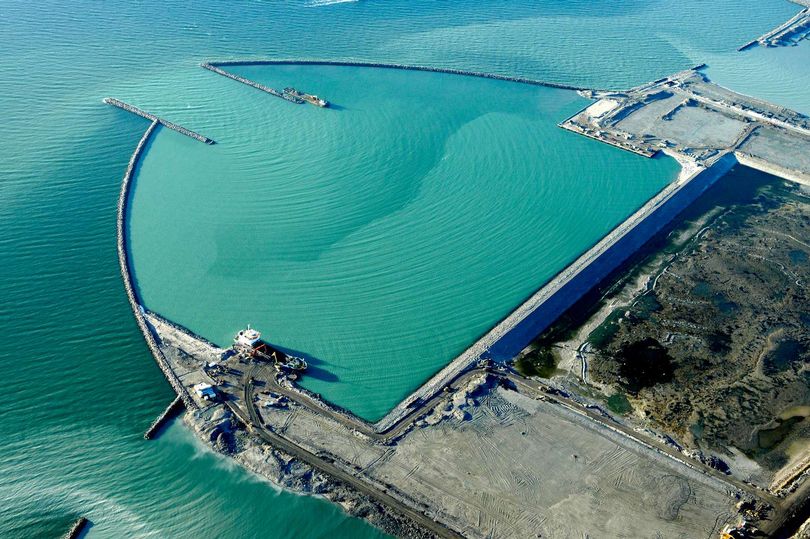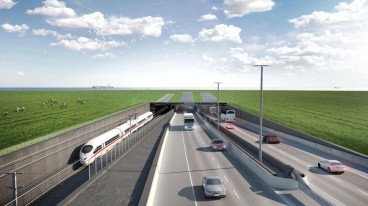Fehmarnbelt Tunnel: Europe's new shortcut links Germany and Denmark

The Fehmarnbelt Tunnel will link Denmark and Germany and is currently one of the largest construction projects in Europe. Its construction will significantly reduce journey times between the two Baltic-facing countries and is expected to open in 2029.
The idea to connect the two countries has long been talked about, either with a bridge or a tunnel, but after a decade of planning it was announced in 2020 that construction of an immersed tunnel would begin in 2021.
At 18 kilometres it's shorter than the 50 kilometre Channel Tunnel by some margin, but it's being built using a different construction process. The Channel Tunnel, which links France and England and cost about €15 billion, was constructed with boring machines.
By contrast, the Denmark to Germany tunnel, expected to cost over €7 billion, will be built on land in modules, floated out to sea where the sections will be dropped into place.
The project’s duration will be eight years and it will actually connect two islands in the Fehmarn Belt, a strait between the Danish island of Lolland and the German island of Fehmarn. Once built, it will offer an alternative to the current ferry service, reducing travel times between the two islands by 35 minutes, to just 10 minutes by car or seven minutes by train.
With the new link in place, the train journey from Hamburg in the north of Germany to Copenhagen, Denmark's capital, will take three hours, down from the current journey time of between four to five hours.
Once built it will also be the longest combined road and rail tunnel anywhere in the world. Travellers will have the option of driving or taking the train as it will consist of two double-lane motorways and two electrified rail tracks.
The 8 kilometre Oresund Bridge, which opened in 2000 and connects Denmark to neighbouring Sweden, is the longest combined road and rail bridge in Europe. Like the Oresund Bridge, the Fehmarnbelt Fixed Link as it is officially known, will be tolled once finally opened. It will also offer a quicker route for freight deliveries from mainland Europe to Scandinavia.
Consequently, considering the Fehmarnbelt Fixed Link in numbers: (i) 8.5 years construction time, (ii) €7.1 billion cost, (iii) 110 km/h max speed for vehicles and 200 km/h for trains, (iv) 50 Eiffel Towers - the equivalent amount of steel that will be used in construction, (v) Predicted lifespan of 100 years.
Sources: buzz.ie, railtech.com, news-europe.fr
Image Gallery
Media
- How the Fehmarnbelt Tunnel is being built
- Construction of the World's Longest Immersed Tunnel turns One Year Old
Want to read more like this story?

Fehmarnbelt Tunnel: The longest underwater rail and road tunnel in the world will connect Germany and Denmark
Feb, 01, 2023 | NewsAn 18-kilometer underwater tunnel will soon connect Germany and Denmark. It should be mentioned tha...

The world's longest submerged tunnel will connect Denmark to Germany
Apr, 24, 2020 | NewsAccording to the government of Denmark, construction works on the longest immersed tunnel in the wo...

3 major East Coast tunnel, the Hudson Tunnel, the Howard Street Tunnel and the Chesapeake Bay Bridge Tunnel, projects move forward
Jan, 11, 2022 | NewsThree major tunnel projects that connect key transportation arteries on the East Coast are advancin...

Casting of Fehmarnbelt tunnel’s precast elements has began
Jul, 10, 2023 | NewsCasting of the elements for the Fehmarnbelt tunnel has now begun, as was announced on July 10. The...

World's Longest Tunnel Running Under Swiss Alps Opens
Jun, 01, 2016 | NewsOn June 1st, the Gotthard Base Tunnel was officially opened, making it the longest and deepest tunne...

Photo gallery: 9 of the world's greatest tunnels!
Jul, 14, 2014 | News2014 is the year of the 20th anniversary of the opening of the Channel Tunnel linking France with th...

Mott MacDonald used PLAXIS to Extend One of the Seven Engineering Wonders of the Modern World
Oct, 23, 2019 | NewsThe Chesapeake Bay Bridge-Tunnel carries US 13, the main north-south thoroughfare on Virginia’s eas...

8 new U.S. tunnels under way: fascinating and challenging
Jan, 10, 2014 | NewsWhether you live in the U.S. or not you will find the following tunnels that are currently being bui...

New tunnel in Swiss Alps changes railway transport in Europe
Sep, 04, 2020 | NewsA significant step has been made for the completion of a great railway project in Europe. The Cen...
On This Day
April 17th 2012
READ MORE
Trending

Richat: The Giant Blue Eye of Africa

What controls the height of the world's mountains?

How Do Dams Trigger Earthquakes?

The story of Nauru is the perfect example of unsustainable mining

California landslides continue as several mansions are red tagged





